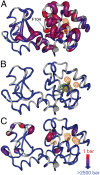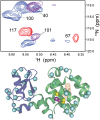Role of cavities and hydration in the pressure unfolding of T4 lysozyme
- PMID: 25201963
- PMCID: PMC4183293
- DOI: 10.1073/pnas.1410655111
Role of cavities and hydration in the pressure unfolding of T4 lysozyme
Abstract
It is well known that high hydrostatic pressures can induce the unfolding of proteins. The physical underpinnings of this phenomenon have been investigated extensively but remain controversial. Changes in solvation energetics have been commonly proposed as a driving force for pressure-induced unfolding. Recently, the elimination of void volumes in the native folded state has been argued to be the principal determinant. Here we use the cavity-containing L99A mutant of T4 lysozyme to examine the pressure-induced destabilization of this multidomain protein by using solution NMR spectroscopy. The cavity-containing C-terminal domain completely unfolds at moderate pressures, whereas the N-terminal domain remains largely structured to pressures as high as 2.5 kbar. The sensitivity to pressure is suppressed by the binding of benzene to the hydrophobic cavity. These results contrast to the pseudo-WT protein, which has a residual cavity volume very similar to that of the L99A-benzene complex but shows extensive subglobal reorganizations with pressure. Encapsulation of the L99A mutant in the aqueous nanoscale core of a reverse micelle is used to examine the hydration of the hydrophobic cavity. The confined space effect of encapsulation suppresses the pressure-induced unfolding transition and allows observation of the filling of the cavity with water at elevated pressures. This indicates that hydration of the hydrophobic cavity is more energetically unfavorable than global unfolding. Overall, these observations point to a range of cooperativity and energetics within the T4 lysozyme molecule and illuminate the fact that small changes in physical parameters can significantly alter the pressure sensitivity of proteins.
Keywords: high-pressure NMR; protein folding and cooperativity; protein hydration; protein stability; reverse micelle encapsulation.
Conflict of interest statement
Conflict of interest statement: A.J.W. declares a competing financial interest as a member of Daedalus Innovations, LLC, a manufacturer of reverse micelle and high-pressure NMR apparatus.
Figures



Comment in
-
Is pressure-induced signal loss in NMR spectra for the Leu99Ala cavity mutant of T4 lysozyme due to unfolding?Proc Natl Acad Sci U S A. 2015 Mar 3;112(9):E923. doi: 10.1073/pnas.1423279112. Epub 2015 Jan 28. Proc Natl Acad Sci U S A. 2015. PMID: 25630507 Free PMC article. No abstract available.
-
Reply to Kitahara and Mulder: An ensemble view of protein stability best explains pressure effects in a T4 lysozyme cavity mutant.Proc Natl Acad Sci U S A. 2015 Mar 3;112(9):E924. doi: 10.1073/pnas.1424002112. Epub 2015 Jan 28. Proc Natl Acad Sci U S A. 2015. PMID: 25630509 Free PMC article. No abstract available.
Similar articles
-
Structure-relaxation mechanism for the response of T4 lysozyme cavity mutants to hydrostatic pressure.Proc Natl Acad Sci U S A. 2015 May 12;112(19):E2437-46. doi: 10.1073/pnas.1506505112. Epub 2015 Apr 27. Proc Natl Acad Sci U S A. 2015. PMID: 25918400 Free PMC article.
-
Structural and thermodynamic characterization of T4 lysozyme mutants and the contribution of internal cavities to pressure denaturation.Biochemistry. 2008 Oct 21;47(42):11097-109. doi: 10.1021/bi801287m. Epub 2008 Sep 25. Biochemistry. 2008. PMID: 18816066 Free PMC article.
-
Structural rigidity of a large cavity-containing protein revealed by high-pressure crystallography.J Mol Biol. 2007 Mar 30;367(3):752-63. doi: 10.1016/j.jmb.2006.12.021. Epub 2006 Dec 15. J Mol Biol. 2007. PMID: 17292912 Free PMC article.
-
Lessons from the lysozyme of phage T4.Protein Sci. 2010 Apr;19(4):631-41. doi: 10.1002/pro.344. Protein Sci. 2010. PMID: 20095051 Free PMC article. Review.
-
Dissection of protein structure and folding by directed mutagenesis.Faraday Discuss. 1992;(93):173-81. doi: 10.1039/fd9929300173. Faraday Discuss. 1992. PMID: 1290931 Review.
Cited by
-
Capturing Invisible Motions in the Transition from Ground to Rare Excited States of T4 Lysozyme L99A.Biophys J. 2016 Oct 18;111(8):1631-1640. doi: 10.1016/j.bpj.2016.08.041. Biophys J. 2016. PMID: 27760351 Free PMC article.
-
Reverse Micelle Encapsulation of Proteins for NMR Spectroscopy.Methods Enzymol. 2019;615:43-75. doi: 10.1016/bs.mie.2018.08.032. Epub 2018 Dec 10. Methods Enzymol. 2019. PMID: 30638537 Free PMC article.
-
Thermodynamic stability of hnRNP A1 low complexity domain revealed by high-pressure NMR.Proteins. 2021 Jul;89(7):781-791. doi: 10.1002/prot.26058. Epub 2021 Feb 15. Proteins. 2021. PMID: 33550645 Free PMC article.
-
Understanding the Relationship between Pressure and Temperature Unfolding of Proteins.JACS Au. 2025 Mar 20;5(4):1940-1955. doi: 10.1021/jacsau.5c00185. eCollection 2025 Apr 28. JACS Au. 2025. PMID: 40313814 Free PMC article.
-
Protein Ensembles: How Does Nature Harness Thermodynamic Fluctuations for Life? The Diverse Functional Roles of Conformational Ensembles in the Cell.Chem Rev. 2016 Jun 8;116(11):6516-51. doi: 10.1021/acs.chemrev.5b00562. Epub 2016 Jan 25. Chem Rev. 2016. PMID: 26807783 Free PMC article. Review.
References
-
- Zipp A, Kauzmann W. Pressure denaturation of metmyoglobin. Biochemistry. 1973;12(21):4217–4228. - PubMed
-
- Royer CA. Revisiting volume changes in pressure-induced protein unfolding. Biochim Biophys Acta. Protein Struct Mol Enzymol. 2002;1595:201–209. - PubMed
-
- Roche J, et al. Remodeling of the folding free energy landscape of staphylococcal nuclease by cavity-creating mutations. Biochemistry. 2012;51(47):9535–9546. - PubMed
Publication types
MeSH terms
Substances
Grants and funding
LinkOut - more resources
Full Text Sources
Other Literature Sources

